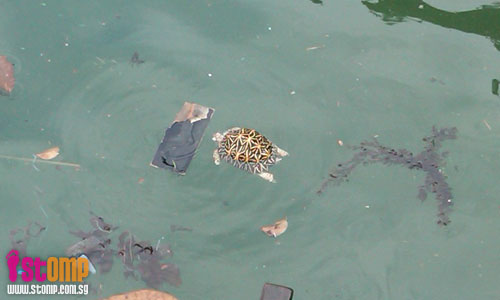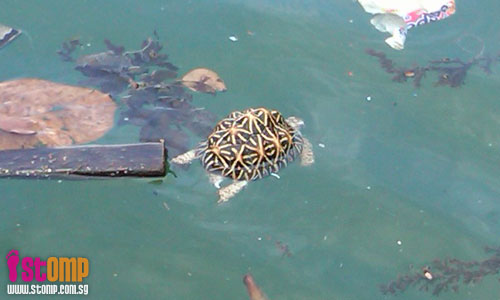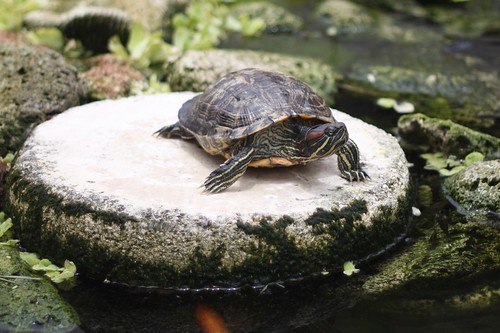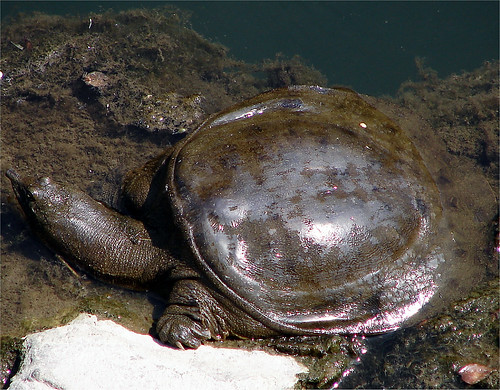
An appalled STOMPer found the body of this Indian star tortoise floating in the waters near Labrador park.
He hopes that people will give unwanted animals to the Zoo or SPCA instead of abandoning them in public areas where they are exposed to danger.
He told STOMP via email today (Jun 25):
"Indian star tortoises are an endangered and protected species.
"It is against the law to keep a star tortoise in Singapore.
"Obviously someone who no knowledge on rearing this endangered has committed murder by abandoning it near Labrador park.
"Indian star tortoises are land animals, they do not swim!
"If anyone is intending to abandon the endangered star tortoise, please give it to the Zoo or SPCA so they will take proper care of it.
"Please do not throw it into the sea, pond or reservoir as it will drown.
"Please see pictures and video taken of the star tortoise found floating at Labrador Park."


Do check out the video posted on STOMP.
I'm absolutely appalled. First by the fact that we had some irresponsible idiot who thought it was a good idea to release an Indian star tortoise (Geochelone elegans), and also by the possibility that the fool was so ignorant that he thought releasing the tortoise into the sea was in its best interests.

Indian star tortoise, Tennessee Aquarium;
(Photo by Richard Nix)
I don't think it can be confirmed that the tortoise was indeed released into the sea. There is always the possibility that it was released on land instead, and was subsequently washed into the sea. Still, I won't be surprised if someone was genuinely so mentally deficient as to have believed that tortoises are aquatic. Marcus has stated before that star tortoises have been released into the pond at East Coast Park, while Andy has blogged about a couple that attempted to release a pair of Chinese softshell turtle (Pelodiscus sinensis) (which are freshwater species) into the sea at Labrador, in the mistaken belief that they were sea turtles.
I mean, come on. How stupid is that? Does anyone seriously believe that the turtles you see being sold in pet shops and markets are sea turtles? Isn't it obvious that the star tortoise is definitely not adapted for an aquatic lifestyle?
Let me try to explain the differences between tortoises, freshwater turtles (sometimes known as terrapins), and sea turtles.

Aldabra giant tortoise (Dipsochelys dussumieri), Aldabra Atoll;
(Photo by Johnny Shaw)
Tortoises all belong to a single family, the Testudinidae. These are turtles that are specialised for a terrestrial lifestyle. They have legs built like pillars or columns, to help support their weight on land. Most tortoise species also have shells that are shaped like domes.
While many tortoise species like to take a soak in a shallow pool on a hot day, they are at best clumsy and cumbersome swimmers. They are entirely terrestrial creatures, and are not meant to swim for long periods of time. There are many books and caresheets warning people not to keep a pet tortoise close to a deep pond, where it might fall in and drown. There is even a webpage by the Tortoise Group that gives advice on how to attempt to resuscitate and care for a tortoise that has fallen into a pond or swimming pool and drowned.

Eastern box turtle (Terrapene carolina), Virginia;
(Photo by derAmialtebloede)
Close relatives of the tortoises, the families Emydidae and Geoemydidae contain the species we commonly know as pond turtles or terrapins. Most species in these families are semi-aquatic to varying degrees, though there are some species belonging to these 2 families that are quite similar to tortoises, in that they spend a lot of time on land. Like tortoises, they are often characterised by having a dome-like carapace. While some of these turtles will spend time close to water, and even soak themselves in shallow pools, many of them are also poor swimmers, and will drown in deep water.

Red-eared slider (Trachemys scripta elegans), Barbados;
(Photo by jcantroot)
As mentioned earlier on, most other turtle species are aquatic, and live in freshwater habitats such as rivers, lakes, and marshes. These species, often called terrapins, tend to divide their time between land and water, with many species feeding in water, but crawling onto dry land to bask in the sun. Compared to tortoises, their shells tend to be somewhat flattened to provide some form of streamlining, and many species have webbed feet. However, if forced to swim non-stop, these turtles will often tire and drown.
Although many of these species can be found living in brackish conditions, few are capable of living in truly marine environments.

Chinese softshell turtle, Itami;
(Photo by muzina_shanghai)
The softshell turtles, which belong to the family Trionychidae, are very well-adapted to an aquatic lifestyle. 1 species in particular, the Chinese softshell turtle, is commonly raised and sold for food here in Singapore, and forms the main ingredient in turtle soup. In softshell turtles, the shell is even flatter, the webbed feet are well-developed, and a long neck and long tubular nostrils enable the turtle to breathe while most of its body remains submerged. These are also mostly freshwater species, although some species are known to live in shallow coastal areas.

Pig-nosed turtle (Carettochelys insculpta), Blue Reef Aquarium Portsmouth;
(Photo by Jim Nicholson)
This relative of the softshell turtles is the most aquatic of the freshwater turtles, with flippers that enable it to fly through the water. The pig-nosed turtle spends its entire life in the water, and never basks on dry land like other aquatic and semi-aquatic turtle species. Although it is predominantly found in freshwater habitats, it is sometimes found in brackish and coastal waters.

Hawksbill turtle (Eretmochelys imbricata), Great Barrier Reef;
(Photo by kaukahi)
At the other end of the spectrum are the sea turtles, which are specialised for life in the open sea. Sea turtles have their limbs modified into flippers. Their shells are flattened, providing a streamlined profile that enables them to minimise drag. Entirely marine creatures, the only time a healthy sea turtle ever comes onto land is when females come ashore to lay their eggs, a laborious and exhausting task. They are so well-adapted to a marine lifestyle that they are practically helpless on land.
As you can see, there is a wide range of habitat preferences, from the entirely terrestrial tortoises, to the entirely marine sea turtles, with various semi-aquatic and aquatic freshwater turtle species in between. To toss a tortoise into the sea thinking that it's meant to live in a marine environment isn't just irresponsible, but also downright cruel and stupid. I can only shudder at how the tortoise must have suffered under the care of a person so ignorant of basic tortoise care. Was it kept in an aquarium full of water and forced to swim all day long, under the assumption that it was aquatic?
Now you can understand why I get very irritated when people mistakenly use the term 'tortoise' to refer to a freshwater turtle, when tortoises are not aquatic in the first place! It gives lazy people who don't bother to check the facts the wrong idea that tortoises live in the water, and leads to unnecessary suffering and cruelty. How woefully ignorant and misguided was this person, thinking that upon release, his tortoise would be swimming away happily in the sea?
I'm seriously getting very angry over this, considering that I have a soft spot for reptiles, and turtles in particular. Indian star tortoises are already threatened due to heavy collection for the pet trade, and while they are banned as pets, I know that they can still be found for sale both locally and in the region. Personally, I have nothing against people who own illegal exotic pets, as long as they are responsible enough to provide the best possible care for the animals. But here we have a case of absolute criminal negligence, and further evidence as to why these reptiles are rightfully banned as pets in Singapore. I don't know about the survival rate of red-eared sliders, but I'm not optimistic about many of them reaching old age. Given that in comparison, Indian star tortoises aren't easy to keep in the first place, I do not dare to think about the mortality rate of all these smuggled Indian star tortoises.
Even if this tortoise had not been deliberately released into the sea, the fact that this person managed to illegally obtain an Indian star tortoise, only to abandon it without regard for its ability to survive in the wild or the possible ecological consequences makes me very angry.
I'm not a violent person, but it's stupidity like this that makes me wish I had been there to shout at the idiot before he committed the act, and maybe throw in a smack on the back of the head for good measure.